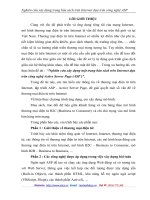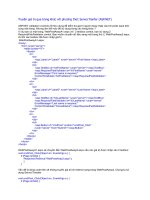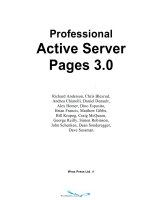active server pages (asp)
Bạn đang xem bản rút gọn của tài liệu. Xem và tải ngay bản đầy đủ của tài liệu tại đây (963.26 KB, 102 trang )
2003 Prentice Hall, Inc. All rights reserved.
1
Active Server Pages (ASP)
Outline
33.1 Introduction
33.2 How Active Server Pages Work
33.3 Setup
33.4 Active Server Page Objects
33.5 Simple ASP Examples
33.6 File System Objects
33.7 Session Tracking and Cookies
33.8 ActiveX Data Objects (ADO)
33.9 Accessing a Database from an Active Server Page
33.10 Server-Side ActiveX Components
33.11 Web Resources
2003 Prentice Hall, Inc. All rights reserved.
2
Objectives
•
In this tutorial, you will learn:
–
To program Active Server Pages using VBScript.
–
To understand how Active Server Pages work.
–
To understand the differences between client-side scripting and server-
side scripting.
–
To be able to pass data between Web pages.
–
To be able to use server-side include statements.
–
To be able to use server-side ActiveX components.
–
To be able to create sessions.
–
To be able to use cookies.
–
To be able to use ActiveX Data Objects (ADO) to access a database.
2003 Prentice Hall, Inc. All rights reserved.
3
33.1 Introduction
•
Server-side technologies
–
Dynamically creates Web pages
•
Use client information, server information and
information from the Internet
–
Active Server Pages (ASP)
•
Microsoft Server-side technology
•
Dynamically build documents in response to
client requests
–
Deliver dynamic Web content
•
XHTML, DHTML, ActiveX controls, client-side
scripts and Java applets
2003 Prentice Hall, Inc. All rights reserved.
4
33.2 How Active Server Pages Work
•
Active Server Pages
–
Processed by scripting engine
•
Server-side ActiveX control
–
.asp file extension
–
Can contain XHTML tags
–
Scripting written with VBScript
•
JavaScript also used
•
Others (Independent Software Vendors)
–
Communication with Server
•
Client HTTP request to server
•
Active server page processes request and
returns results
2003 Prentice Hall, Inc. All rights reserved.
5
33.2 How Active Server Pages Work
•
Active Server Pages,cont.
–
Communication with Server, cont.
•
ASP document is loaded into memory
–
asp.dll scripting engine on server
•
Parses (top to bottom)
2003 Prentice Hall, Inc. All rights reserved.
6
33.3 Setup
•
Web Server
–
Need to run Web server to use Active Server Pages
•
IIS 5.0 (Internet Information Services) or
higher
–
Create a virtual directory
•
Copy files to c:\InetPub\Wwwroot
2003 Prentice Hall, Inc. All rights reserved.
7
33.4 Active Server Page Objects
•
Built-in objects
–
Communicate with a Web browser
–
Gather data sent by HTTP request
–
Distinguish between users
–
Request
•
Get or post information
•
Data provided by the user in an XHTML form
•
Access to information stored on client machine
–
Cookies
–
File upload (binary)
–
Response
•
Sends information to client
–
XHTML, text
–
Server
•
Access to server methods or properties
2003 Prentice Hall, Inc. All rights reserved.
8
33.4 Active Server Page Objects
Object Name Description
Request
Used to access information passed by an HTTP request.
Response
Used to control the information sent to the client.
Server
Used to access methods and properties on the server.
Fig. 25.1
Commonly used ASP objects.
2003 Prentice Hall, Inc. All rights reserved.
9
33.5 Simple ASP Examples
•
ASP Scripts
–
Scripting delimiters
•
<% %>
•
@LANGUAGE directive
–
Option Explicit
•
As in VBScript, forces all variables to be
declared in advance
–
FormatDateTime
•
Time to display
–
Now
•
Format to display in
2003 Prentice Hall, Inc.
All rights reserved.
Outline
10
1
<% @LANGUAGE = VBScript %>
2
3
<%
4
' Fig. 33.2 : clock.asp
5
' A simple ASP example
6
Option Explicit
7
%>
8
9
<!DOCTYPE html PUBLIC "-//W3C//DTD XHTML 1.0 Transitional//EN"
10
"
11
12
<html xmlns = "
13
14
<head>
15
<title>A Simple ASP Example</title>
16
17
<style type = "text/css">
18
td { background-color: black;
19
color: yellow }
20
strong { font-family: arial, sans-serif;
21
font-size: 14pt; color: blue }
22
p { font-size: 14pt }
23
</style>
24
25
</head>
clock.asp
(1 of 2)
Scripting delimiter
wraps around code
executed on the server.
Processing directive
specifying scripting
language
Requires programmer explicitly
define all variables
2003 Prentice Hall, Inc.
All rights reserved.
Outline
11
26
27
<body>
28
29
<p><strong>A Simple ASP Example</strong></p>
30
<table border = "6">
31
<tr>
32
<td>
33
<% =FormatDateTime( Now, vbLongDate ) %>
34
</td>
35
36
<td>
37
<% =Time() %>
38
</td>
39
</tr>
40
</table>
41
</body>
42
43
</html>
clock.asp
(2 of 2)
Returns server date and time
(Now) as a string formatted in
vbLongDate format
“<%=“ is short for
Response.write
Statement is short for:
<% Call Response.write( Time()) %>
2003 Prentice Hall, Inc. All rights reserved.
12
33.5 Simple ASP Examples
Fig. 33.2 Simple Active Server Page.
2003 Prentice Hall, Inc.
All rights reserved.
Outline
13
HTML generated by
clock.asp
(1 of 2)
1
<!DOCTYPE html PUBLIC "-//W3C//DTD XHTML 1.0 Transitional//EN"
2
"
3
4
<html xmlns = "
5
6
<head>
7
<title>A Simple ASP Example</title>
8
9
<style type = "text/css">
10
td { background-color: black;
11
color: yellow }
12
strong { font-family: arial, sans-serif;
13
font-size: 14pt; color: blue }
14
p { font-size: 14pt }
15
</style>
16
17
</head>
18
19
<body>
20
2003 Prentice Hall, Inc.
All rights reserved.
Outline
14
HTML generated by
clock.asp
(2 of 2)
21
<p><strong>A Simple ASP Example</strong></p>
22
<table border = "6">
23
<tr>
24
<td>
25
Thursday, May 24, 2001
26
</td>
27
28
<td>
29
2:22:58 PM
30
</td>
31
</tr>
32
</table>
33
</body>
34
35
</html>
2003 Prentice Hall, Inc. All rights reserved.
15
33.5 Simple ASP Examples
•
ASP processes input
–
Form information sent by client
–
E-commerce Web site
•
Use to verify customer information
–
Server responds to process request
–
Form
•
Using post method
•
action attribute indicates the .asp file to
which the form information is posted
–
Request object retrieves form data
2003 Prentice Hall, Inc.
All rights reserved.
Outline
16
1
<!DOCTYPE html PUBLIC "-//W3C//DTD XHTML 1.0 Transitional//EN"
2
"
3
4
<! Fig. 33.4 : name.html >
5
<! XHTML document that request an ASP document >
6
7
<html xmlns = "
8
9
<head>
10
<title>Name Request</title>
11
</head>
12
13
<body>
14
15
<p style = "font-family: arial, sans-serif">
16
Enter your name:
17
</p>
18
name.html
(1 of 2)
2003 Prentice Hall, Inc.
All rights reserved.
Outline
17
19
<! request name.asp when posted >
20
<form action = "name.asp" method = "post">
21
<input type = "text" name = "namebox" size = "20" />
22
<input type = "submit" name = "submitButton"
23
value = "Enter" />
24
</form>
25
26
</body>
27
28
</html>
action set to ASP file
where information is
posted.
name.html
(2 of 2)
2003 Prentice Hall, Inc. All rights reserved.
18
33.5 Simple ASP Examples
Fig. 33.4 XHTML document that requests an ASP.
2003 Prentice Hall, Inc.
All rights reserved.
Outline
19
1
<% @LANGUAGE = VBScript %>
2
3
<%
4
' Fig. 33.5 : name.asp
5
' Another simple ASP example
6
Option Explicit
7
%>
8
9
<!DOCTYPE html PUBLIC "-//W3C//DTD XHTML 1.0 Transitional//EN"
10
"
11
12
<html xmlns = "
13
14
<head>
15
<title>Name Information</title>
16
17
<style type = "text/css">
18
p { font-family: arial, sans-serif;
19
font-size: 14pt; color: navy }
20
.special { font-size: 20pt; color: green }
21
</style>
22
</head>
name.asp
(1 of 2)
2003 Prentice Hall, Inc.
All rights reserved.
Outline
20
23
24
<body>
25
26
<! retrieve and display namebox's value >
27
<p>Hi <% =Request( "namebox" ) %>, </p><br />
28
<p class = "special">Welcome to ASP!</p>
29
30
</body>
31
32
</html>
name.asp
(2 of 2)
Request object retrieves
form data from text field
“namebox”
2003 Prentice Hall, Inc. All rights reserved.
21
33.5 Simple ASP Examples
Fig. 33.5 ASP document that responds to a client request.
2003 Prentice Hall, Inc. All rights reserved.
22
33.6 File System Objects
•
File System Objects (FSOs)
–
Allow programmer to manipulate files, directories and drives
–
Read and write text
–
Microsoft Scripting Runtime Library (Fig 33.6)
•
FileSystemObject, File, Folder, Drive and
TextStream
–
Use to create directories, move files, determine whether a Drive exists
•
FileSystemObject methods (Fig. 33.7)
–
File object
•
Allows programmer to gather info about files,
manipulate files, open files
•
File properties and methods (Fig. 33.8)
2003 Prentice Hall, Inc. All rights reserved.
23
33.6 File System Objects
Object type Description
FileSystemObject
Allows the programmer to interact with
File
s,
Folder
s and
Drive
s.
File
Allows the programmer to manipulate
File
s of any type.
Folder
Allows the programmer to manipulate
Folder
s (i.e., directories).
Drive
Allows the programmer to gather information about
Drive
s (hard
disks, RAM disks—computer memory used as a substitute for hard
disks to allow high-speed file operations, CD-ROMs, etc.).
Drive
s
can be local or remote.
TextStream
Allows the programmer to read and write text files.
Fig. 33.6
File System Objects (FSOs).
2003 Prentice Hall, Inc. All rights reserved.
24
33.6 File System Objects
Methods Description
CopyFile
Copies an existing
File
.
CopyFolder
Copies an existing
Folder
.
CreateFolder
Creates and returns a
Folder
.
CreateTextFile
Creates and returns a text
File
.
DeleteFile
Deletes a
File
.
DeleteFolder
Deletes a
Folder
.
DriveExists
Tests whether or not a
Drive
exists. Returns a boolean.
FileExists
Tests whether or not a
File
exists. Returns a boolean.
FolderExists
Tests whether or not a
Folder
exists. Returns a boolean.
GetAbsolutePathName
Returns the absolute path as a string.
Fig. 33.7
FileSystemObject
methods. (Part 1 of 2)
2003 Prentice Hall, Inc. All rights reserved.
25
33.6 File System Objects
Methods Description
GetDrive
Returns the specified
Drive
.
GetDriveName
Returns the
Drive
drive name.
GetFile
Returns the specified
File
.
GetFileName
Returns the
File
file name.
GetFolder
Returns the specified
File
.
GetParentFolderName
Returns a string representing the parent folder name.
GetTempName
Creates and returns a string representing a file name.
MoveFile
Moves a
File
.
MoveFolder
Moves a
Folder
.
OpenTextFile
Opens an existing text
File
. Returns a
TextStream
.
Fig. 33.7
FileSystemObject
methods. (Part 2 of 2)









